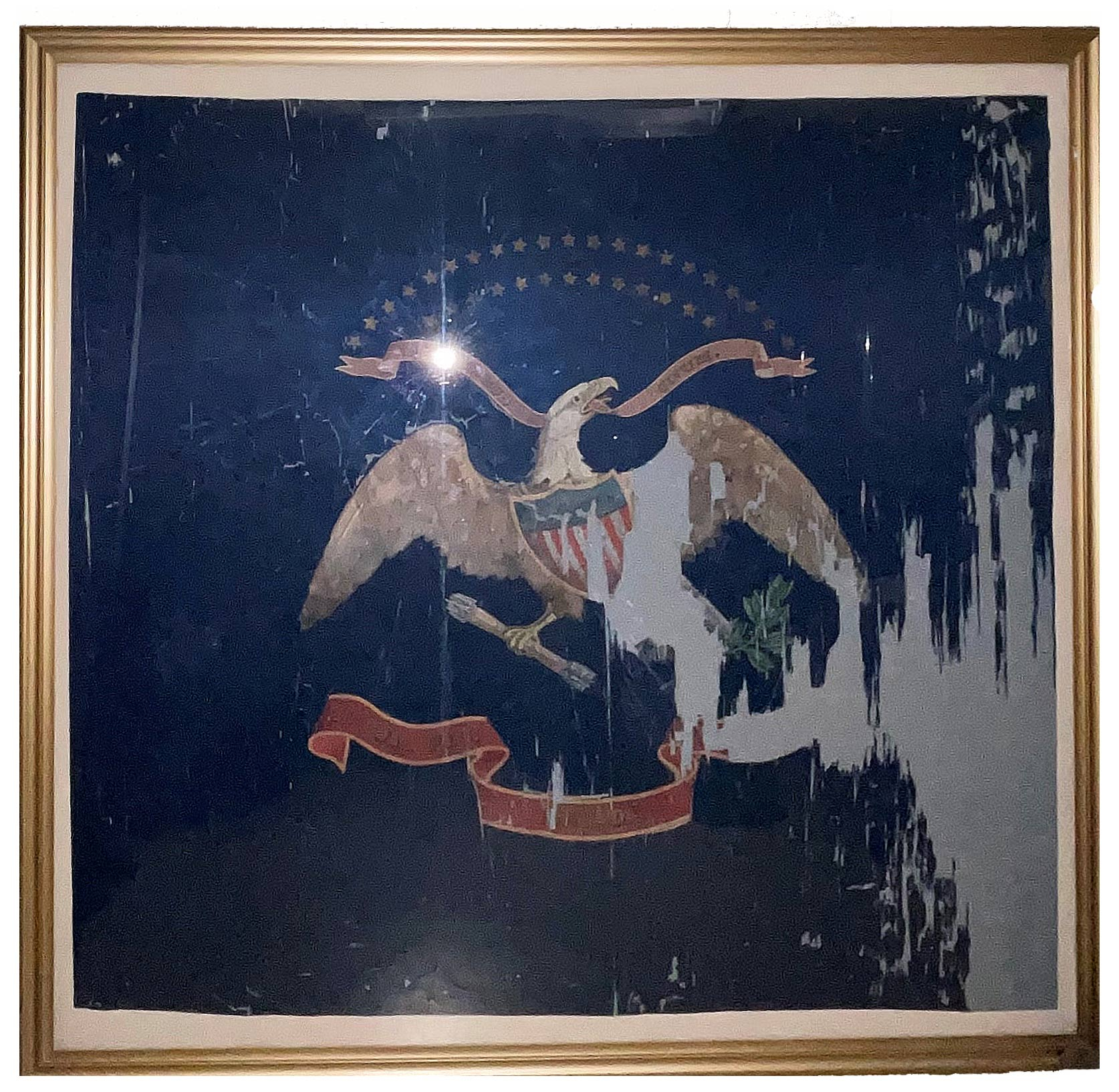site search
online catalog
REGIMENTAL COLOR OF THE 197TH PENNSYLVANIA - “THIRD COAL EXCHANGE REGIMENT” - LIKELY BY EVANS AND HASSALL, PHILADELPHIA

Hover to zoom


$25,000.00 SOLD
Quantity Available: None
Item Code: 1179-025
This regimental color is pictured in Volume 2, p.496, of Advance the Colors where it is noted as the only extant flag of the 197th Pennsylvania, one of six Pennsylvania infantry regiments, numbered 192 to 197, raised to help repel the Confederate invasion of Maryland in July 1864. Sponsored by the Coal Exchange in Philadelphia, the regiment received the nickname 3rd Coal Exchange Regiment. The regiment’s field officers and many of its line officers and enlisted men had prior military service. An extant recruiting poster in the Smithsonian advertises a $50 city bounty and $16 a month in pay for recruits, with Col. John R. Haslett’s headquarters at “the Coal Exchange Room, Walnut Street below Dock.”
The flag is constructed of a single layer of blue silk and follows regulations in showing an eagle at center with United States shield on its chest, clutching arrows and olive branch. An arc of two rows of gold stars is above the eagle, which clutches in its beak a 1 ½” red ribbon lettered in ¾” gold characters, “E PLURIBUS / UNUM.” Underneath is a 3” red ribbon reading, “3rd COAL REGT. / PHILADA / 197th PENNA. VOLS.” The leading edge is 72” and the fly is 76” with a 2” pole sleeve. The flag conforms to Philadelphia Depot pattern regimental colors supplied by Evans and Hassall (see Arms and Equipment of the Union for some parallels.) Evans and Hassall were also the source for the flag of the 2nd Coal Exchange Regiment, 51st PA Militia, in the Zaricor collection.
The flag is accompanied by two detailed analysis and treatment conservation reports by Textile Preservation Associates, one dated 1989 when it was owned by a Las Vegas collector, and the second in 1993 when it was at the Branson Civil War Museum. The flag is 85% intact with most of the losses and conservation work on the fly end, indicating use, loss of the fringe, which is not a major detraction. The flag displays very well. Interested parties should view our photographs and are invited to inspect the conservation reports. The flag was most recently displayed at the Texas Civil War Museum and the analysis and treatment reports include detailed instructions for handling, display, and storage.
The 1864 invasion of Maryland, perhaps better classified as a large raid, was Lee’s effort to relieve pressure at Petersburg by dispatching Jubal Early to the Shenandoah Valley and from there into Maryland where he could threaten Baltimore and Washington. Skirmishes along the way culminated in the Battle of Monocacy on July 9, a defeat for Union forces, but one that bought enough time for reinforcements to reach the defenses of Washington. Early reached the city on July 11, vainly attacked Fort Stevens on July 12, and pulled back into Virginia on July 14. Fort Stevens, of course, was notable in having President Lincoln present as an observer of the fighting. The regiment mustered into service for 100 days at Camp Cadwalader in Philadelphia from July 14 to July 22, while the crisis was still unresolved and was posted to Camp Bradford in Mankin’s Woods at Baltimore as part of the 8th Corps, Middle Department. After about two weeks it was clear the crisis had passed and in August the regiment was transferred to Illinois for guard duty at the Rock Island prisoner of war camp. It served there until November, mustering out at Philadelphia on November 11, 1864.
Regimental colors are among the most dynamic of Civil War flags. [sr] [ph:ss]
EXTRA SHIPPING REQUIRED.
~~~~~~~~~~~~~~~~~~~~~~~~~~~~~~~~~~~
THIS ITEM, AS WITH ALL OTHER ITEMS AVAILABLE ON OUR WEB SITE,
MAY BE PURCHASED THROUGH OUR LAYAWAY PROGRAM.
CLICK HERE FOR OUR POLICIES AND TERMS.
THANK YOU!
Inquire About REGIMENTAL COLOR OF THE 197TH PENNSYLVANIA - “THIRD COAL EXCHANGE REGIMENT” - LIKELY BY EVANS AND HASSALL, PHILADELPHIA
Most Popular
Historical Firearms Stolen From The National Civil War Museum In Harrisburg, Pa »
Theft From Gravesite Of Gen. John Reynolds »
Selection Of Unframed Prints By Don Troiani »
Fine Condition Brass Infantry Bugle Insignia »
Large English Bowie Knife With Sheath 1870’S – 1880’S »
Imported (Clauberg) Us Model 1860 Light Cavalry Officer's Saber »
featured item
CAVALRY OFFICER’S SABRE IDENTIFIED TO CAPTAIN MARCUS A. MOORE, 1ST MASSACHUSETTS CAVALRY
Manufactured: Newark, NJ Maker: Sauerbier, Henry Year: Early Civil War Model: Model 1840 transitional with 1860 style grip Size: 34.2 inch blade, 1.17 wide, .353 thick This sword has all true Type 1 features with the exception of the Model 1860 style… (870-159). Learn More »


